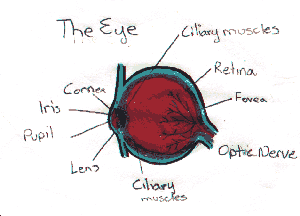
![]()
Click on the words to see more details!!
Then there is the retina, which in the eye plays the role of film in a camera, the retina is located on the curved rear surface. It consists of a complex array of nerves and receptors known as rods and cones which act to change light energy into electr ical signals that travel along the nerves. In the center of the retina is the fovea, where the cones are very closely packed and the sharpest image and best color discrimination are found.
The lens of the eye does little of the bending of the light rays. Most of the refraction is done at the front surface of the cornea, which also acts as a protective covering. The lens acts as a fine adjustment for focusing at different distances. This is accomplished by the ciliary muscles, which change the curvature of the lens so its focal length is changed.

![]()
Click on the words to see more details!!